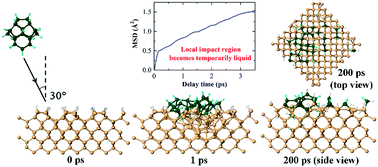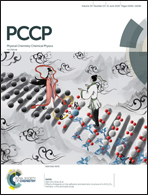Deposition of hydrogenated silicon clusters for efficient epitaxial growth†
Abstract
Epitaxial silicon thin films grown from the deposition of plasma-born hydrogenated silicon nanoparticles using plasma-enhanced chemical vapor deposition have widely been investigated due to their potential applications in photovoltaic and nanoelectronic device technologies. However, the optimal experimental conditions and the underlying growth mechanisms leading to the high-speed epitaxial growth of thin silicon films from hydrogenated silicon nanoparticles remain far from being understood. In the present work, extensive molecular dynamics simulations were performed to study the epitaxial growth of silicon thin films resulting from the deposition of plasma-born hydrogenated silicon clusters at low substrate temperatures under realistic reactor conditions. There is strong evidence that a temporary phase transition of the substrate area around the cluster impact site to the liquid state is necessary for the epitaxial growth to take place. We predict further that a non-normal incidence angle for the cluster impact significantly facilitates the epitaxial growth of thin crystalline silicon films.



 Please wait while we load your content...
Please wait while we load your content...